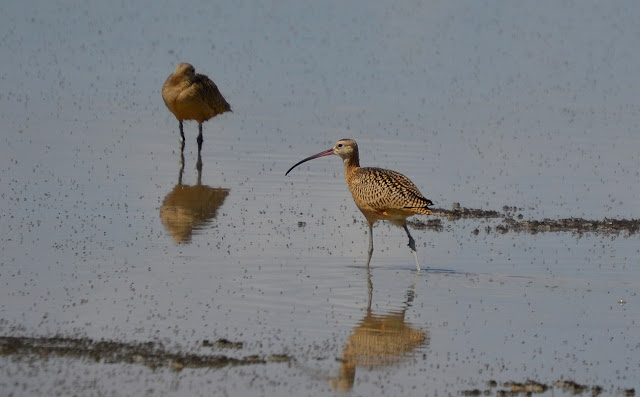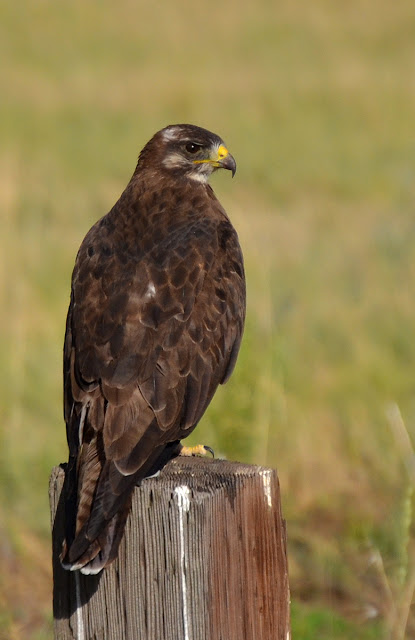Another real highlight of our trip to Utah was the time we spent in Antelope Island State Park, situated on a large island surrounded by the Great Salt Lake. The environment here was such a strong contrast to the mountains we'd already been exploring -- there were basically no trees on the island, and very few flowers, just expanses of mostly-brown low-lying plants and rock and sandy shores:
But there was plenty of life on the island, and lots of cool creatures to see. At the park's visitors' center, we got a special treat among the building's rafters. Not only were there hundreds of Barn Swallows swooping around, building their mud nests in the shelter of the roof:
But one of the staff members pointed out a Barn Owl nest to us as well, complete with four big babies of varying fluffiness (the fourth owl is hiding in this picture):
That's certainly not something you get to see every day! (Or, I guess you would if you worked at the Antelope Island visitors' center!)
On one of the higher ridges on the island, we had our only reptile encounter of the trip (we somehow managed to avoid snakes), an impressive Tiger Whiptail (Aspidoscelis tigris):
What a striking pattern this lizard has, and I think I can see where it gets its name -- it does have a remarkably long tail:
Down on the shores of the Great Salt Lake, the most numerous creature by far was the Brine Fly. There were so many of these insects that they made black clouds above the surface of the lake, and the clouds shifted -- looking and sounding like waves of water -- whenever someone walked toward them. (You can find some really awesome videos of this phenomenon if you search for "brine flies" and "great salt lake" on YouTube.) The entire beach was ringed with just tons of the flies' leftover pupal casings, making thick brown bands along the shoreline:
The flies weren't at all harmful, and some people were even swimming in the water (I wasn't tempted). Several California Gulls were also wandering around snapping up the flying meals:
A group of Long-billed Curlews was also present at the beach, but they seemed more interested in resting than hunting flies:
There were actually many more birds along the shores of the island, and the Great Salt Lake apparently provides an important source of food for birds, especially during migration. We saw a huge number and variety of shorebirds (gulls, avocets, sandpipers, terns...) as we drove along the causeway that connects the island to the rest of the state, but the many signs along that road warned us not to leave our cars, so we didn't take the chance to explore further.
Towards the interior of the island, we found some of the bigger attractions of the park: large mammals. Pronghorns were only re-introduced to the island in 1993 (they were presumably wiped out many years ago, when the island was a ranch), and they seem to be doing well now. We drove by a small herd of female Pronghorns:
And we saw one lone male Pronghorn, off in the distance (they're such funny-looking -- and cool! -- creatures):
But one of the biggest draws to this park is the island's population of American Bison, which was established in the late 1800s and is managed to maintain a size of around 600 individuals (the island is only so big). We drove by quite a few of these wonderfully massive creatures and stopped to watch them graze:
I think this is probably the closest I've been to a bison. So cool!
I kind of just wanted to hug these guys. I didn't do it, but I wanted to.
We didn't get to see any of the baby bison that are currently on the island, nor did we see the herd in large numbers, but just getting to be close to these creatures was a great experience.
So Antelope Island was awesome, and we didn't even see everything the park has to offer. (There's a population of Bighorn Sheep on the island, and Burrowing Owls.) Maybe someday I'll get to go back....
I have one final sight from the Utah trip to share. On the way back from Antelope Island, we drove a little way into the Bear River Migratory Bird Refuge to see what was hanging around. It was pretty quiet overall, but we did get a close view of a Swainson's Hawk -- one of the bigger raptors in the area -- perched on a fence post by the road:
Raptors are always impressive, and this was a nice end to an exciting day.
I had a great time
visiting Northeastern Utah and getting to see so much varied habitat and
wildlife. What a wonderful introduction to that part of our country!
















Spectacular! Thanks for sharing your trip - your photos are always terrific ... a very special shot is the one of the flicker captured in the moment of take-off! :-)
ReplyDeleteThanks! I'm glad you enjoyed the pictures!
Delete